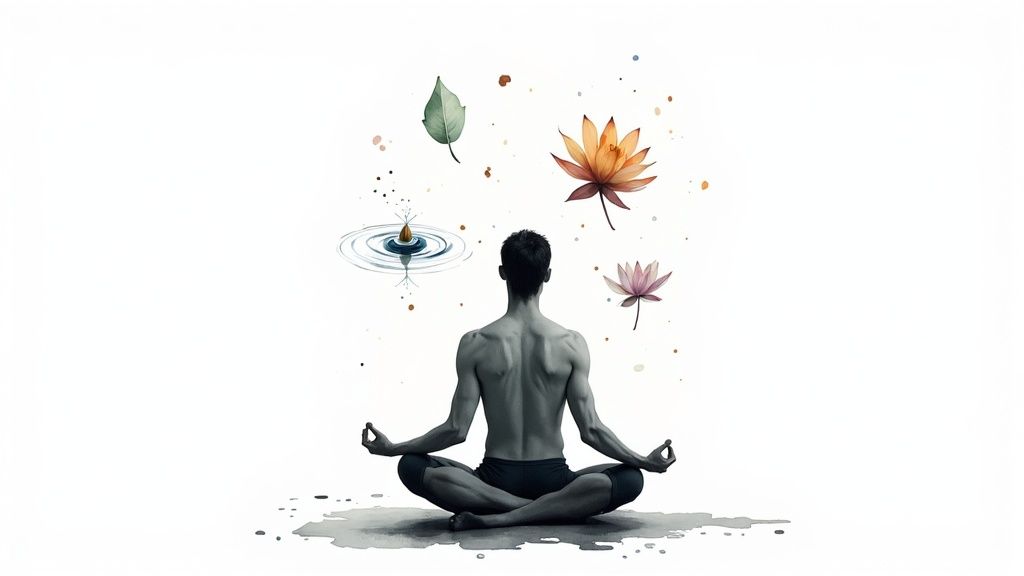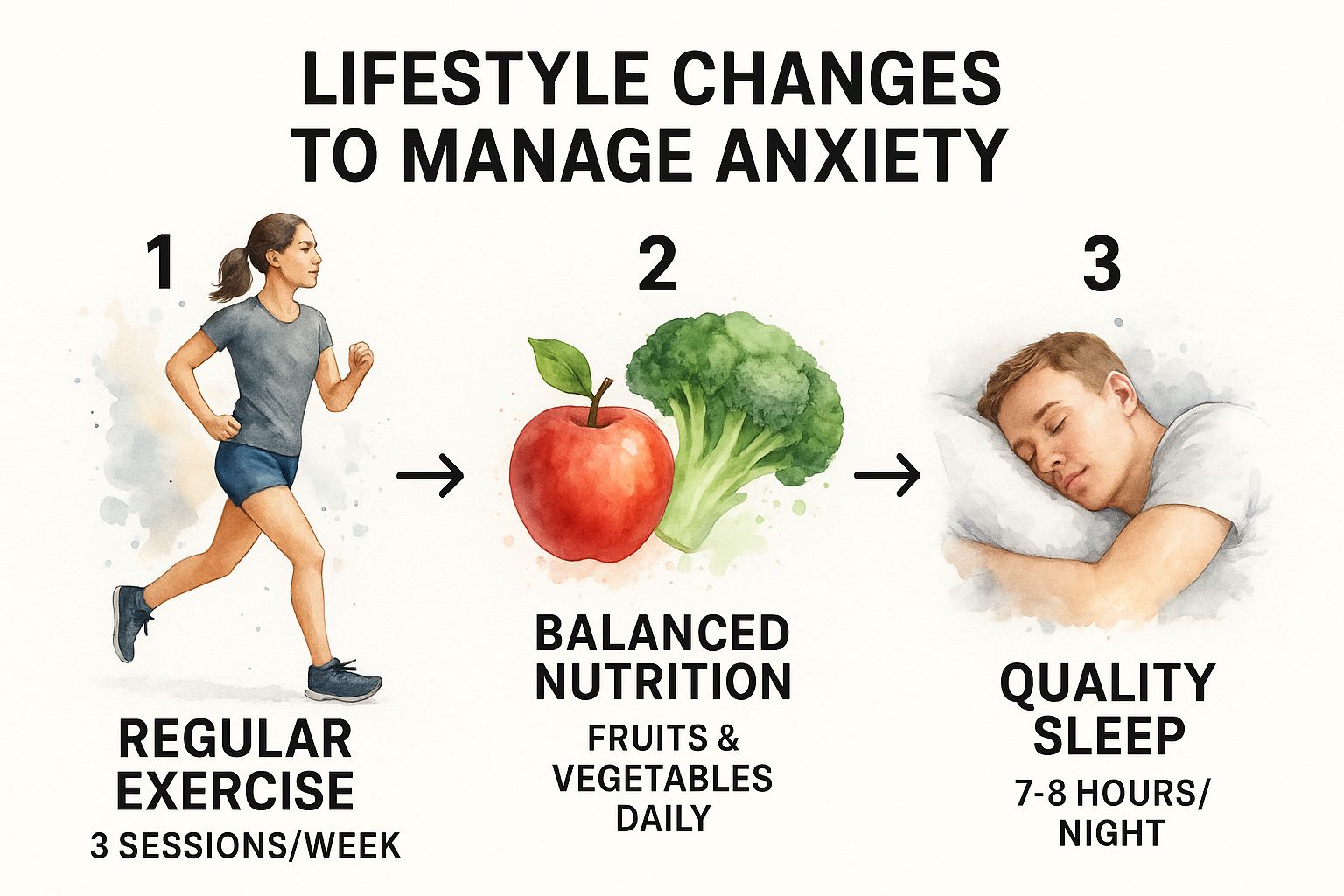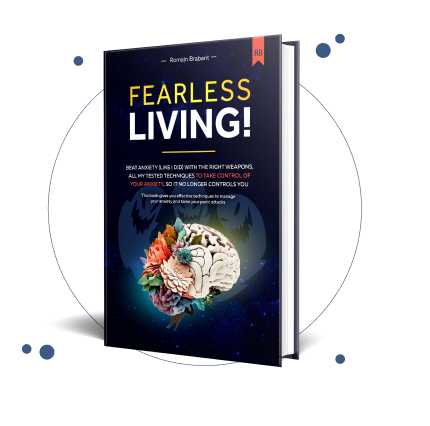
Coping with anxiety isn't about wishful thinking or just trying to "be positive." It's about getting your hands on practical tools that help you manage your thoughts, soothe your body, and build a more resilient lifestyle. It’s about learning you have the power to heal and influence how you feel, not by ignoring the anxiety, but by using actionable techniques that dismantle its grip, piece by piece, on your path to a panic-free life.
You Are Not Alone in Feeling Anxious
If you've ever felt completely overwhelmed by anxiety—the racing heart, the spiraling thoughts, the feeling that you're totally isolated in your struggle—I want you to know something. You are far from alone, and there is a clear path forward.
This guide isn't here to tell you to just push your feelings aside. It's here to show you that healing is possible by understanding anxiety for what it truly is: a normal human response that’s gone into overdrive, not a personal failing on your part.
Recognizing this is the first real step toward getting better. Anxiety isn't a life sentence or some deep flaw in your character. Think of it more like a smoke alarm that's become overly sensitive and now goes off for something as simple as burnt toast. The good news? You can learn to recalibrate that alarm and live peacefully.
Dismantling the Myth of a Life Sentence
So many people feel trapped by their anxiety, believing it’s just an unchangeable part of who they are. That belief is paralyzing. It can make the very idea of a panic-free life feel like a distant, impossible dream. But here's the empowering truth: you can absolutely learn to dial down the intensity, heal, and get back in the driver's seat.
This journey is all about learning real, practical techniques to:
- Quiet the internal noise and endless mental chatter.
- Regain a sense of control when you feel completely overwhelmed.
- Start living a calmer, more present life, one moment at a time.
The path to feeling better starts with a single, hopeful step. Just believing that change is possible is the foundation. It shifts your entire perspective from feeling helpless to feeling empowered on your healing journey.
If you need proof of how common these feelings are, just look at recent world events. The COVID-19 pandemic triggered a massive global spike in anxiety, with a 25% increase in just its first year. The social isolation, fear, and constant disruption showed us that anxiety is often a reaction to overwhelming external stress—not some internal weakness. You can read the full findings from the World Health Organization on this global mental health challenge.
Moving from Surviving to Thriving
Getting to a place where you truly understand that you can cope with anxiety is the first major milestone. It's not about finding a magic cure, but about building a personal toolkit of strategies that genuinely work for you and lead to lasting healing.
Every technique you learn is another tool in your belt, giving you more confidence to face situations that once felt terrifying and proving that a panic-free life is within your reach.
This guide will give you those tools. We'll walk through how to manage anxious thoughts, calm your body’s physical freak-outs, and build a lifestyle that actually supports your mental well-being. And for those who want a more structured path, a program like our Anxiety University can provide a comprehensive roadmap for your journey.
The path to a calmer life is real, and it starts right now.
Rewire Your Anxious Thought Patterns

Anxiety often feels like an external force, something that just happens to you. In reality, a huge chunk of that overwhelming feeling starts with a single, quiet thought. And that is actually fantastic news. If your thoughts are playing a starring role, it means you have a powerful way to influence how you feel and begin to heal.
This isn't about that frustrating advice to just "think positive." That approach usually backfires because it ignores the deep-seated mental habits that fuel anxiety. Instead, we're going to get into some concrete, actionable tools inspired by Cognitive Behavioral Therapy (CBT) to actively reshape those habits.
The goal is to go from being a passenger on a runaway train of anxious thoughts to becoming the conductor—slowing it down and choosing its direction. This is how you start to truly heal and build a life where panic isn't in the driver's seat.
Spotting Your Anxious Thought Traps
Before you can change your thoughts, you have to know what you’re looking for. Anxious minds have a knack for falling into predictable, unhelpful patterns called cognitive distortions, or "thought traps." They twist reality just enough to make situations seem far more threatening than they are.
Learning to spot these traps is like flipping on a light in a dark room. You suddenly see the mental furniture you’ve been tripping over, and you realize you can rearrange it.
Here are a few of the most common ones:
- Catastrophizing: This is the "what if" master. Your mind takes a small concern and immediately jumps to the absolute worst-case scenario. A simple typo in a work email becomes, "I'm definitely getting fired."
- All-or-Nothing Thinking: Also known as black-and-white thinking, this trap sees no shades of gray. If you aren't a complete success, you're a total failure. If a social event isn't perfect, it was a disaster.
- Mind Reading: You assume you know what other people are thinking—and it's almost always negative. "Everyone at this party thinks I'm awkward." You treat these assumptions as cold, hard facts, with zero evidence.
- Overgeneralization: You take a single negative event and spin it into a never-ending pattern of defeat. One tough job interview means, "I'll never get a job."
Recognizing these patterns as they happen is the first step to disarming them. You can't heal what you can't see.
The Catch, Check, Change Method
Once you get better at spotting these thought traps, you need a system to deal with them on the spot. The "Catch, Check, Change" method is a simple but powerful way to cope with anxiety by interrupting its automatic cycle.
Let's walk through it with a real-world scenario.
Scenario: You have to give a presentation at work next week, and the dread is already building.
1. Catch the Thought
The first step is to simply notice the automatic negative thought as it pops up. Don't judge it; just catch it. The thought might be something like, "I'm going to stumble over my words, everyone will think I'm incompetent, and this will ruin my reputation." That's pure catastrophizing.
2. Check the Thought
Now, put on your detective hat. Interrogate the thought and search for evidence. Is it 100% true?
- Have I ever given a presentation before without it being a total catastrophe? (Almost certainly, yes).
- What's a more realistic outcome? (I might be nervous, but I'll get through it. Some parts will go well, others might be a bit clunky).
- What would I tell a friend who had this exact thought? (You’d likely be much kinder and more rational).
3. Change the Thought
Finally, swap the initial anxious thought for one that's more balanced, realistic, and hopeful. It doesn't have to be blindly positive—just grounded in reality. The new thought could be, "I'm nervous about the presentation, and that's normal. I'll prepare well, and even if I make a small mistake, it's not the end of the world. My competence is defined by all my work, not just one speech."
This process breaks the automatic link between a trigger (the presentation) and your anxious response.
Key Insight: You are not your thoughts. Thoughts are just temporary mental events, like clouds passing in the sky. You don't have to believe every single one that floats through your mind. This realization is a cornerstone of healing.
This skill—observing your thoughts without getting tangled up in them—is sometimes called "cognitive defusion." It creates a tiny but crucial space between you and your thinking, giving you just enough room to breathe and choose how you want to respond.
By practicing this consistently—catching, checking, and changing—you are literally rewiring your brain for healing. You’re weakening old, anxious neural pathways and strengthening new, more balanced ones. It takes practice, but this is the work that builds lasting resilience and paves the way to a life where you, not your anxiety, are in control.
Soothe Your Body to Calm Your Mind

While anxious thoughts can feel like the main event, your body is often where the first alarm bells start ringing. A pounding heart, shallow breathing, or tense shoulders aren't just side effects; they are core parts of the anxiety experience.
This physical response can be terrifying, but here’s a hopeful truth: by learning to soothe your body, you can send a powerful "all-clear" signal directly to your brain. This is about working with your biology, not against it.
When anxiety strikes, your body is simply trying to protect you. It’s activating a primal, hardwired system designed for survival. The good news is that you have the power to calm this system down. In doing so, you regain a profound sense of control and safety—a crucial step toward living a life free from panic.
The Fight-or-Flight Response Explained
That sudden surge of physical symptoms—the racing pulse, the dizzy feeling, the shaky hands—is known as the fight-or-flight response. It's your body's ancient, automatic alarm system, designed to prepare you to either fight off a threat or run away from it.
When your brain perceives danger (whether it's a real physical threat or a stressful thought), it floods your system with adrenaline. This is why your heart beats faster—to pump more blood to your muscles. It's why your breathing quickens—to get more oxygen into your system.
Seeing these physical signs not as proof that something is terribly wrong, but as a normal (though overactive) biological process, is incredibly empowering. It reframes the experience from "I'm in danger" to "My body is trying to protect me, and I can guide it back to calm." This simple shift in perspective is the first step in learning how to cope with anxiety on a physical level.
Ground Yourself with the 5-4-3-2-1 Method
When you're stuck in a spiral of anxious thoughts, one of the most effective ways to break the cycle is to pull your attention back into the present moment. Grounding techniques do exactly that by reconnecting you with your physical senses.
The 5-4-3-2-1 method is a simple yet powerful tool you can use anywhere, anytime.
Here’s how it works:
- Acknowledge 5 things you can see. Look around and notice five distinct objects. A pen on your desk, a crack in the ceiling, a car driving by outside. Say them out loud or in your head.
- Acknowledge 4 things you can feel. Tune into the sensation of touch. Notice the texture of your shirt, the solid ground beneath your feet, or the smooth surface of your phone.
- Acknowledge 3 things you can hear. Listen carefully for three distinct sounds. It might be the hum of a refrigerator, distant traffic, or your own breathing.
- Acknowledge 2 things you can smell. Try to identify two scents in your environment, like the smell of coffee or the faint scent of rain on the pavement.
- Acknowledge 1 thing you can taste. Focus on one thing you can taste. You could take a sip of water or simply notice the current taste in your mouth.
This exercise forces your brain to switch from abstract worry to concrete, immediate sensory input, effectively interrupting the anxiety loop.
Hopeful Takeaway: Your senses are powerful anchors to the present moment. By consciously engaging them, you prove to yourself that you can steer your focus away from fear and back to the safety of the here and now. Each time you do this, you strengthen your ability to manage panic and find peace.
For many people, finding a sense of calm is amplified by companionship. Many find solace and emotional support in their pets; for example, you can explore the profound connection between dogs and love and how that bond can provide comfort.
Master Your Breath with the 4-7-8 Technique
Your breathing pattern is directly linked to your nervous system. Short, shallow breaths signal panic, while slow, deep breaths signal calm. The 4-7-8 breathing technique is a simple but effective method for manually shifting your body out of its anxious state and into a state of healing.
Here’s the breakdown:
- Exhale completely through your mouth, making a whoosh sound.
- Close your mouth and inhale quietly through your nose to a mental count of four.
- Hold your breath for a count of seven.
- Exhale completely through your mouth, again with a whoosh sound, to a count of eight.
Repeat this cycle three to four times. The extended exhale is key, as it stimulates the vagus nerve, which helps regulate your heart rate and promotes a state of relaxation.
Sometimes, in the heat of the moment, it helps to have a quick menu of options. Here are a few simple physical techniques you can use to find calm right when you need it most.
Immediate Anxiety Calming Techniques
A quick-reference guide to simple, effective techniques you can use anytime to reduce physical symptoms of anxiety.
| Technique | How It Works | When to Use |
|---|---|---|
| Cold Water Splash | Activates the "dive reflex," slowing heart rate and redirecting blood flow to the brain. | When you feel a sudden surge of panic or feel flushed and overheated. |
| Progressive Muscle Relaxation | Involves tensing and then releasing muscle groups to release stored physical tension. | Ideal before bed or when you notice tension in your shoulders, jaw, or fists. |
| Mindful Movement | Gentle stretching or walking that brings your focus to the physical sensations of your body. | When you feel restless, jittery, or stuck in your head. |
These aren't just distractions; they are physiological "hacks" that send a direct message to your nervous system that you are safe. Learning these physical tools is a direct path to showing yourself that you can heal and live a panic-free life.
If you'd like to explore more guided breathing and mindfulness practices, check out our guide on how meditation can significantly reduce anxiety.
Build an Anxiety-Resilient Lifestyle

While learning to calm your body and mind in a moment of panic is a critical skill, the real game-changer is building a life where anxiety has less room to take hold in the first place. This is where hope truly begins to grow. You can create such a strong foundation of well-being that it acts as a natural buffer against stress, making you fundamentally more resilient.
This isn’t about some dramatic, overnight life overhaul. Far from it. It’s about making small, consistent shifts that compound over time, creating a profound sense of calm and control. Every small choice is a step toward a future where you aren't just surviving anxiety—you're genuinely thriving.
Craft a Calming Bedtime Routine
Anxiety and sleep are tangled in a complicated dance. A racing mind can make drifting off feel impossible, and a night of poor sleep leaves you wide open to anxiety the next day. It’s a vicious cycle that can feel unbreakable. But you can interrupt it by creating a predictable and soothing bedtime routine, opening the door to healing rest.
The whole point is to send clear signals to your brain and body that it's time to wind down. This means stepping away from anything that stimulates you and turning your bedroom into a sanctuary for rest.
Try weaving a few of these into your evening:
- Go Screen-Free an Hour Before Bed: The blue light from our phones and TVs messes with melatonin, the hormone that tells your body it's time to sleep. Put your devices away and pick up a book or listen to a quiet podcast instead.
- Take a Warm Bath or Shower: This does more than just relax tense muscles. The drop in your body temperature after you get out actually helps promote sleepiness.
- Stretch Gently: Focus on the spots where you carry tension, like your neck and shoulders. It's a simple way to physically release the stress of the day.
This routine becomes a powerful anchor—a predictable set of actions that tells your anxious mind the day is done and it's safe to rest.
Fuel Your Mind with Anxiety-Reducing Nutrition
The connection between your gut and your brain is incredibly powerful. What you eat directly impacts your mood, your energy, and your ability to handle stress. While no single food is a magic bullet, certain eating habits can help stabilize your mood and dial down the physical symptoms of anxiety, creating a foundation for healing.
Focus on incorporating whole, nutrient-dense foods that give your nervous system the support it needs. For example, the complex carbohydrates in oats and whole grains help your body produce serotonin, a neurotransmitter with a naturally calming effect.
Key Takeaway: Think of food as information you're sending your body. Stabilizing foods send a message of calm. On the other hand, sugary and highly processed foods can send signals that create jitteriness and mood swings, which feel a lot like anxiety itself.
Many people find that simple, mindful tweaks to their diet make a huge difference. For a deeper dive, our guide on lifestyle and diet changes for anxiety management offers specific advice you can start using today.
Move Your Body to Move Past Anxiety
Physical activity is hands-down one of the most effective non-medical tools for keeping anxiety in check. Exercise helps your body burn off excess cortisol (the stress hormone) and releases endorphins, which are basically natural mood-lifters. Study after study shows that regular physical activity reduces tension, improves sleep, and boosts self-esteem.
You don't need to sign up for a marathon to feel the benefits. The secret is finding a type of movement you actually enjoy, because that turns it into a sustainable habit instead of another chore on your to-do list, making it a joyful part of your healing process.
Types of Anxiety-Reducing Exercise:
| Activity Type | How It Helps | Example |
|---|---|---|
| Rhythmic Aerobic Exercise | Gets your heart rate up, improves circulation, and releases endorphins. The repetitive motion can feel meditative. | Brisk walking, jogging, cycling, or swimming. |
| Mindful Movement | Connects physical action with mental focus, which helps you feel grounded and more aware of your body. | Yoga, Tai Chi, or even a slow, deliberate walk in nature. |
| Strength Training | Builds physical resilience and can boost confidence as you see yourself getting stronger over time. | Lifting weights, using resistance bands, or bodyweight exercises. |
The most important piece of the puzzle is consistency. Aiming for 30 minutes of moderate activity most days of the week is a fantastic goal. This steady effort reinforces the message to your body and mind that you are strong, capable, and in control.
How to Navigate a Panic Attack
A panic attack feels like the world is ending. Your heart is hammering against your ribs, the room starts to spin, and a chilling sense of doom washes over you. In that moment, your brain screams that you're in grave danger.
But here’s the most important truth to hold onto: a panic attack is temporary, it is not physically dangerous, and you absolutely have the power to get through it.
This isn't about fighting the panic—that often just adds fuel to the fire. It's about learning to ride the wave with confidence, knowing it will always, always break and recede. Think of this as your personal protocol, an anchor in the storm. Every time you successfully navigate an attack, you're rewriting the script, proving to your brain that you're in control and paving the way for a panic-free life.
Reframe the Experience
The first move toward regaining control is to change how you see the panic itself. A panic attack is just a massive, sudden surge of adrenaline. That's it. It’s your body's fight-or-flight system misfiring—an internal false alarm.
When the physical sensations hit—the racing heart, shortness of breath, dizziness—remind yourself of this fact. Say it out loud if you have to: "This is just adrenaline. It feels terrifying, but it's not harmful. This feeling will pass." This simple act of reframing can break the vicious cycle where scary physical symptoms fuel more panicked thoughts, which in turn crank up the physical symptoms.
You are not going crazy. You are not having a heart attack. You're experiencing a treatable, temporary burst of anxiety that you can learn to manage and ultimately heal from.
Anchor Yourself in the Present
When panic takes over, your mind is usually off to the races, catastrophizing about what might happen. The quickest way to short-circuit this is to pull your focus out of your head and into the physical world around you. Grounding techniques are your best friend here.
Try one of these simple methods:
- Focus on Your Feet: Really feel them planted firmly on the ground. Notice the texture of your socks or the cool sensation of the floor. Wiggle your toes. This simple action reconnects your brain to your body and the solid earth beneath you.
- Touch Something with Texture: Run your fingers over the rough fabric of your jeans, the smooth surface of a table, or a cool piece of metal. Concentrate entirely on that single sensation of touch.
- Listen for Distant Sounds: Instead of zeroing in on your pounding heart, strain to hear the furthest sound you can detect. Is it traffic in the distance? A bird chirping? The hum of a refrigerator?
These actions force your brain to process the here-and-now, leaving less mental real estate for the panic to occupy.
You can also find a comprehensive list of strategies and a step-by-step guide for what to do in our detailed article covering a full panic attack protocol. It's a valuable resource to have ready.
The infographic below shows how consistent lifestyle choices can build your resilience against anxiety, making panic attacks less likely over time.

This process highlights how foundational habits in exercise, nutrition, and sleep work together to create a stable base for your mental health.
Breathe to Avoid Hyperventilation
During a panic attack, you might feel like you can't get enough air, which leads to quick, shallow breathing. This is hyperventilation, and it's what causes that tingling and lightheadedness that makes panic feel even more terrifying.
The goal isn't just to breathe, but to slow your breathing down, focusing specifically on a long, controlled exhale.
Try Box Breathing:
- Inhale slowly through your nose for a count of four.
- Hold your breath gently for a count of four.
- Exhale slowly and completely through your mouth for a count of four.
- Hold your breath out for a count of four.
Repeat this cycle several times. The deliberate rhythm restores balance to your nervous system and sends a powerful signal to your brain that you are not, in fact, in danger. It's a direct way to manually take back the controls of your body's response. Each calm breath is a step toward a life where you feel safe and empowered.
As you start putting these strategies to work, you're bound to have questions. That's actually a great sign—it means you're really digging in and getting serious about your healing. Below are some honest answers to the most common questions I hear, designed to give you a realistic roadmap and remind you that you absolutely can feel better.
This journey is all about progress, not perfection. Every single step forward, no matter how small it feels, is a win. It's what builds momentum toward a calmer, more confident you.
What Does Recovery from Anxiety Really Mean?
A lot of people ask if "recovering" from anxiety means it just vanishes forever. A much more helpful—and realistic—way to think about it is in terms of management and resilience. The goal isn't to become a robot who never feels anxious. After all, anxiety is a normal human emotion that, in small doses, actually helps us.
Instead, recovery is when you get to a place where:
- Anxiety no longer runs the show, dictates your choices, or shrinks your world.
- You feel equipped with the tools and the confidence to handle anxious moments when they pop up.
- Panic attacks become rare or even stop completely because you know exactly how to short-circuit the fear cycle.
I like to think of it like learning to sail. You can't control the ocean, but you can become a skilled captain who knows how to navigate the waves. True recovery is the freedom that comes from trusting yourself to handle whatever weather comes your way.
How Long Until I Feel Better?
This is probably the most common and understandable question of all. While there's no magic, one-size-fits-all timeline, many people start noticing small but meaningful shifts within a few weeks of consistent practice. Maybe your heart doesn't pound quite as hard in a stressful meeting, or you find you can quiet a racing thought a little faster than before.
The key here is consistency over intensity. A five-minute breathing exercise every single day is far more powerful than a one-hour session once a month.
These small, daily actions are what literally build new pathways in your brain, weakening the old, automatic anxiety response. So be patient with yourself. You're essentially un-learning patterns that might have been there for years. Celebrate those small wins—they are the true building blocks of lasting change and healing.
When Should I Seek Professional Support?
Using the tools in this guide is a powerful way to reclaim your well-being. But knowing when to call in reinforcements is a sign of strength, not a sign of failure. Reaching out to a mental health professional is one of the most proactive and courageous steps you can take on your healing journey.
It might be time to consider professional help if:
- Your anxiety is consistently getting in the way of your work, relationships, or just getting through the day.
- You feel like you're spinning your wheels, trying different strategies without much progress.
- You find yourself relying on unhealthy ways to cope, like avoiding situations or using substances.
- You're starting to feel hopeless or believe you'll never get better.
A good therapist can offer a clear diagnosis, provide proven treatments like Cognitive Behavioral Therapy (CBT), and build a plan tailored just for you. Think of them as a trained ally dedicated to your healing. Many people find that combining self-help strategies, like these powerful grounding techniques for anxiety, with professional guidance is the fastest and most sustainable path to a life where you are back in control. Remember, asking for help is a wise and powerful act of self-care.
The journey to a calmer mind is a real and achievable goal. With the right tools and a structured approach, you can move from just coping to truly thriving. The Anxiety Checklist provides a complete system with our Fearless Living eBook and interactive checklist to guide you every step of the way, turning proven strategies into a personalized toolkit for your success. Take control and start building your panic-free life today at https://anxietychecklist.com.

